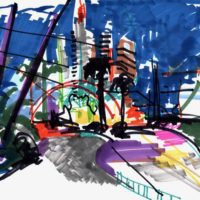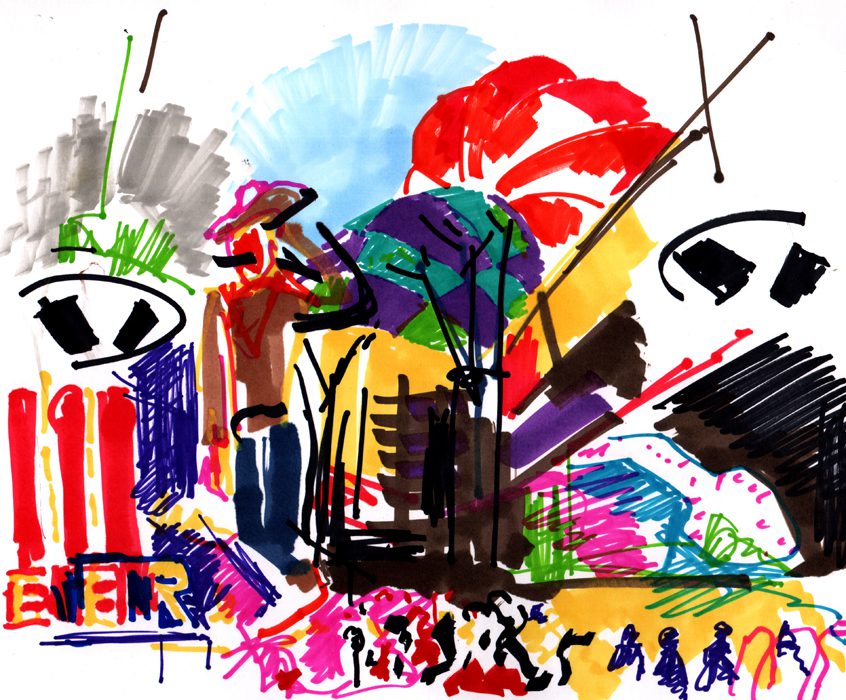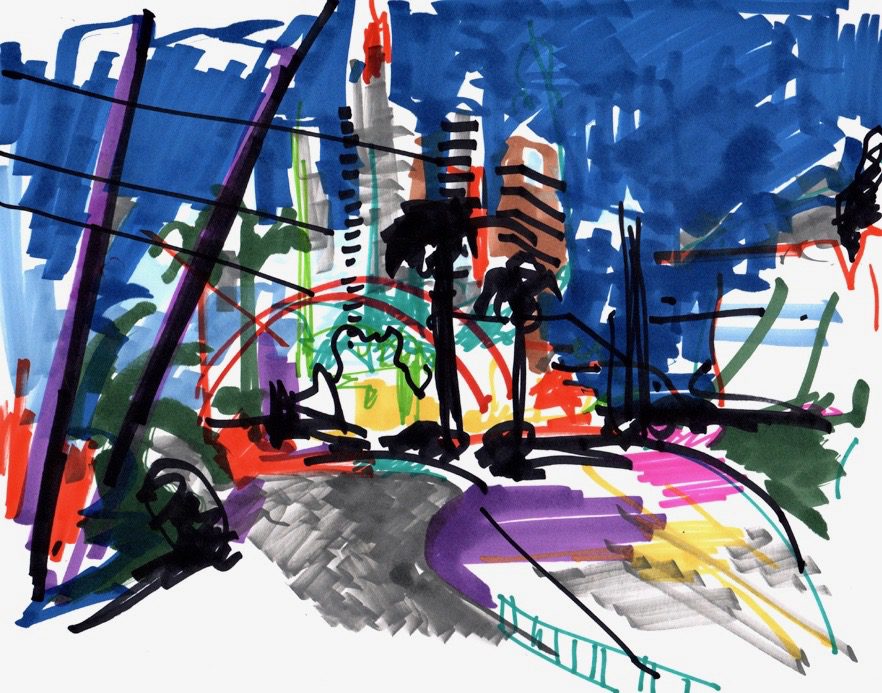1.
When I tell people I lived in Las Vegas for three years while studying to write fiction in an MFA program at the University of Nevada, a short silence usually follows, before they blurt out something along the lines of: Jesus, what was that like? Did you gamble all the time?
Perhaps it’s hard to reconcile the image of the creative writing workshop that comes to mind—a Brutalist building on a leafy college campus somewhere in the Midwest or New England, eager young minds debating literature in the thrall of their wise, graying professor—with the debauched hedonism and low-brow excess associated with Vegas, that desert outpost of all-night drinking, casinos, strippers, buffets; a place that offers countless possibilities for saying yes to the questionable life choices you’re sure to regret forty-eight hours later.
Because I’m from LA, I’d been to Vegas at least a dozen or so times before I moved there for grad school. Bachelorette parties or a last-minute weekend binge: play the cheap slots for free cocktails, stand in long lines for admission into nightclubs to sweat and grind with strangers on the dance floor, stumble up to the hotel room at four in the morning, wake up around noon with an awful hangover, down a thirty-two-ounce Gatorade and hit the buffet, then the pool, and doing it all again a second night.
Which is to say I knew nothing about Vegas outside the Strip, that four-mile-long stretch of casinos, shopping malls, and hotel towers that encourage tourists to abandon their inhibitions, the contents of their checking accounts, for the weekend.
What happens in Vegas, stays in Vegas; a punchline to give yourself permission to risk it all, as if touching down at McCarranor exiting Las Vegas Boulevard off the I-15 meant you were transported to another dimension, a place without consequence, and that you should act accordingly. Living in Las Vegas was quite a different story. And what happens in the creative writing workshop doesn’t stay there—not that you’d want it to.
2.
After classes, friends from my cohort would cross Maryland Parkway for happy hour drinks at the Stakeout, a dive situated in a strip mall across from campus, next to a Jimmy John’s and a pawn shop with a “We Buy Gold for Cash” sign in the window. The bar was dimly lit, boxy TVs hoisted up in the corners. A haze of cigarette smoke hung in the air, settling into your hair, clinging to your clothes. You could call the place depressing; the regulars who patronized the Stakeout were rough-looking men who sat along the bar with their eyes glued to the video poker screens, fingers swiping and tapping, feeding bills into the machines.
We—the fiction writers—liked the Stakeout for its cheap alcohol, the greasy bar snacks, all of it the unpretentious backdrop against which we earnestly discussed our “work,” compared notes on our professors, and gossiped about the poets.
Some of us liked to gamble on the cheap at El Cortez, a dilapidated downtown casino where you could play two-dollar poker and throw dice at the craps table without losing your shirt. Gambling didn’t hold any thrill for me, though. My favorite Vegas activity involved buying a Budweiser tallboy from the corner liquor store and walking up and down the Fremont Experience, a five-blocks-long outdoor pedestrian mall covered by a curved LED canopy that strobed psychedelic animations and pumped out electronic dance music.
There was no better place to people-watch than Fremont Street in downtown Vegas. Vendor kiosks dotted the concrete mall, hawking Vegas-themed t-shirts, keychains spelled with your name, neon feather boas, and bedazzled shot glasses. Overhead, flying bodies shot across the length of the LED screen, adrenaline junkies braving the zipline. Casino marquees—Four Queens, Golden Nugget, Binion’s Horseshoe—glittered and flashed over the sea of people slowly trudging back and forth, stopping now and then to gape at some thrilling spectacle unfolding on the mall.
Beautiful young women decked out as classic Vegas showgirls—feather headpiece, rhinestone bra, opera gloves, and bare legs—preened a few feet away from life-sized Elmo and Winnie the Pooh characters. All four members of KISS were there, black-and-white face makeup, head-to-toe leather, stomping around on their tall platform boots. Elvis leered and swished his cape, struck a pose in his white satin suit. I saw 2Pac on Fremont once. Handsome and shirtless, a white bandanna knotted over his forehead. Strolling past, he caught me staring and winked. My heart skipped in my chest. The likeness was uncanny.
3.
Before the MFA I’d taken exactly one fiction writing class. I’d only ever written about two and a half stories. Certainly, I knew nothing about the discipline of revising, starting over from a blank page after writing that initial shitty draft. My first workshop in grad school was eye-opening, generous—and brutal.
The story I’d turned in was set in LA, the narrator a Taiwanese American woman who’d recently split with her girlfriend. To cheer her up, the narrator’s dirtbag (male) best friend takes her out for a bros’ night out in Koreatown. Soju shots, dduk bok gi and hot wings, desperate karaoke solos, doumi hostesses down to party for a price, all of which led to an eruption of long-repressed rage about a sexual encounter between the friends years before, an incident they remember differently—he recalls an awkward threesome, she regrets her complicity in a drunken date rape. Things don’t end well that night for the future of their friendship.
In the workshop, one of my white classmates said, “I don’t know how I’m supposed to read this story. I just don’t believe it.” She shook her head and added, “These people don’t seem real to me.” I remember the concerned expression she wore, her eyes full of dismay roving around the room for confirmation, confident she was only saying aloud what everyone else must already be thinking.
I wondered then—I still do—if her confusion stemmed from a lack of imagination about contemporary Asian American characters in fiction. Later on, in another workshop, she would turn in a story about an abused Chinese girl who runs away from an orphanage with only the clothes on her back. The protagonist sneaks onto a boat headed for America and eventually wins the affections of a white family, leading to her happily-ever-after as the joyful adopted daughter with her very own bedroom in a big beautiful house.
Unlike what she’d said about my story, I knew exactly how to read hers. I wasn’t confused about its intention. It was a very well-executed white savior fantasy.
4.
Many of the resorts on the Strip are pastiches of far-flung cities with historic significance, and I used to wonder how many visitors to Las Vegas chose to vacation there because they couldn’t afford to honeymoon in the real Paris in France, or to book a family trip to the actual Bellagio that sits upon Lake Como in Lombardy, Italy. There must be more than a few tourists who take in the Vegas replicas—the half-size Eiffel Tower and two-thirds scale Arc de Triomphe, the diminutive Lady Liberty outside New York New York—with hopes of seeing and touching the original landmarks one day.
Then again, I wonder if the distinct pleasure of Las Vegas lies in the simulacrum. That is, the pleasure of experiencing a simulation that is so far removed from actual reality as to be beyond parody: a city built on pure hyperreality, a fantasy wholly in and of itself.
I think about my experience in the fiction workshop, the white woman who wanted to write about a poor Chinese orphan girl, and did write it, and felt compelled to turn it in as her submission. If I hadn’t been in the room, an actual Chinese person, would the critique have gone on differently? Was her story a pastiche? Certainly, she didn’t mean to write it as a parody.
The feelings she tried to telegraph through the protagonist—loneliness, loss, yearning for family, and a sense of belonging—were sincere, told plaintively and without irony. I felt them there, when I paused long enough to extend my compassion toward her as a fellow writer, another human struggling to adapt to a new life in Las Vegas.
I knew that she was a single mother, recently divorced. It couldn’t be easy. To anyone who’d listen she spoke about her ex with unbridled vehemence; she shared her teenage daughter’s accomplishments, too, with the same sort of high animation, shot through with happiness and pride and something like relief.
Still, I couldn’t help but to read her story as parody. The Orientalist clichés and inaccurate cultural references angered me, and I said as much during the workshop that week. Someone told me they saw her in the woman’s bathroom crying, upset afterwards. Did I feel compassion for her then? No, I didn’t.
I didn’t have the words for it at the time, but our professor did. He affixed her story in the column of the unreal, in the kindest way possible, I thought, by addressing craft: verisimilitude versus fabulism in fiction. I remember breathing a sigh of relief at how artfully he diffused the tension in the room. Craft was where we could meet each other, all of us writers, after all.
Years later, I’m still grateful for what he said at the end of that workshop, which confirmed for me that her story wasn’t a pastiche, or even a parody. It was a Chinese hyperreality. The problem with discussing craft as if the art of making fiction lives in a vacuum, however, is an inadvertent flattening of creative writing as an expression of social identities such as class, race, gender, sexuality, and more, as if how we’re taught to write and what we read to learn writing aren’t often tilted toward a hegemonic identity long made invisible.
What I mean to say is that my classmate who wrote the Chinese orphan girl story probably never expected for the fantastical universe she’d created to be received by anyone except a reader not too unlike herself: a liberal-minded, college-educated, middle-class white person.
If a Chinese story is written and there are no Chinese readers of the story, is it still a Chinese story? Does it matter?
These people don’t seem real to me. The story she’d said that about was my attempt at a particular kind of Southern California millennial culture Asian American verisimilitude. Did I fail because of craft? Were my characters too thinly drawn? The dialogue stilted and corny?
In the MFA, I pressed on. I wasn’t fully aware of it at the time, but I was teaching myself to write stories for an ideal reader who didn’t exist in my classrooms. I was living, perhaps, in my own hyperreality. That story I’d turned in to my first MFA workshop lives somewhere in my computer still. Draft after draft, cuts and rewrites, I couldn’t figure out how to get it right, so I gave up. I wrote something new, then another, and another.
5.
Graduation approached, and all of us were desperate to find a way to keep the writing dream alive after the degree. I applied to the handful of creative writing fellowships everyone applies to, was rejected to every single one. It was clear now that I needed to come back to Earth after three years in an MFA and find a job.
I’d heard the cautionary tales about writers in the post-MFA hustle who signed on to the adjunct circuit as a way to stay in academia, underpaid and overworked, with no health insurance. If I chose to stay in Vegas, where the cost of living was significantly lower than LA, I might be better off with a job on the Strip. I’d had some experience already; in my second year in school, I’d taken on a part-time retail job at a store inside the Fashion Show mall, the hulking shopping complex across the street from the Wynn and Encore resorts.
One of my co-workers there was dating a Jonas brother; she’d met him at her other job as a cocktail server at Tao, the exotic Far East-themed nightclub inside Venetian, the Northern Italy coast-themed luxury hotel. On one of our lunch breaks she showed me clips from the hip-hop music videos in which she’d starred, sliding her finger along the scrubber bar on the bottom of her phone screen; she knew exactly when the camera panned over her come-hither smile while she relaxed in the hot tub with a glass of champagne next to Ludacris.
Another one of my co-workers was a regional pageant queen with her eye on the Miss Nevada crown. She, too, worked as a cocktail server but at a day club, and thus only during Vegas’s pool season, the months between Memorial Day and Labor Day when temperatures often rise above one hundred degrees. Though she was easily one of the most beautiful women I’d ever met in my life, she felt insecure about her status year over year at the pool, as returning female staff are required to audition for their jobs every season. The job at the mall paid far less than the tips she earned at the day club’s bottle service cabanas, but she saw it as a way out of hospitality, perhaps an inroads to retail management or fashion merchandising. She was twenty-seven and needed other career options, she said.
When I’d told her I was in my thirties and back in school as a graduate student, she stuck out her tongue. “For what?” she asked. “You go to UNLV?”
I said I was getting an MFA in fiction and writing a book. She lifted an eyebrow and slowly nodded. “As in, Barnes and Noble?” she said.
I couldn’t tell if she was skeptical or impressed. Maybe it was a little bit of both, not unlike how I felt when I imagined her at the day club job: expertly taking orders and carrying out food and drinks, projecting fun and confidence to her customers while wearing that royal purple string bikini uniform, sweating and smiling in the bright blistering heat.
6.
I ultimately decided to move back home, to LA. I put away my thesis for a long while, at least six months. I put away Las Vegas, too. There’s so much I’ve forgotten, it seems. I started writing this essay to try to remember things, not as they were, of course, but to examine how they appear to me now, from this distance.
Las Vegas sits in a valley of the Mojave, but for me, the “desert” experience encompassed more than just a hot, arid climate.
Despite the city’s reputation for grandiosity, there were days when living in Vegas felt small-town, provincial. The city’s art museum had shuttered a couple years before I moved there, an unfortunate effect of the economic downturn in the late 2000s. There wasn’t a single independent bookstore in which to dally and browse (there is now: the wonderful Writer’s Block, which opened in 2014, the year I left).
After a night out at one of the local bars my friends and I frequented—besides the Stakeout, there was the Pepper Mill, decorated with red velvet banquettes, real fire pits, fake leafy trees, and a mirrored ceiling, and Free Zone on Friday nights for the unparalleled drag show, ten-dollar beer bust and all-night dancing—I would come home to my little room at the back of the house with the sun-bleached rocks on the lawn, in that suburban cul-de-sac, my hair full of cigarettes, and lie down with loneliness. My own personal desert.
In what one might think of as the oddest place to do so, I learned to turn inward, to face myself and cultivate solitude. A different kind of spectacle than what happens in Vegas, stays in Vegas: I wrote it all down, as best as I could.
***
Rumpus original art by Dmitry Samarov.







